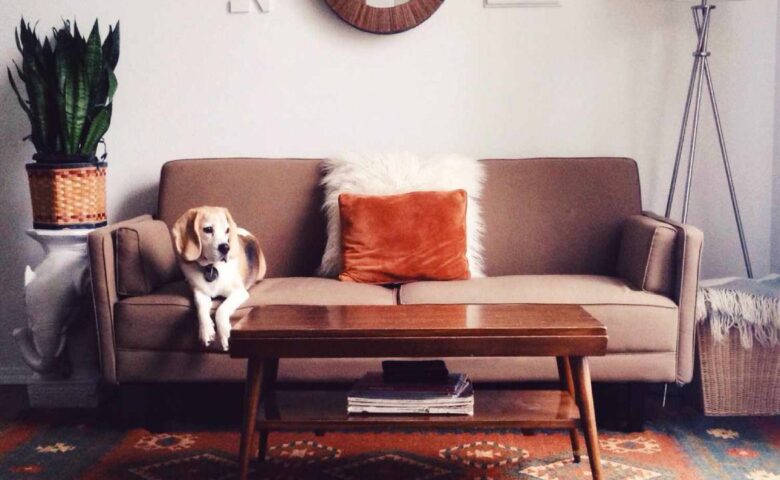Every pet owner knows how hard it can be to keep nice furniture with a fur-baby around. Don’t wrap your couches in plastic or lock your sweet baby in the bedroom. Just choose furniture that can live with your pet!
1. Think about fabric
When choosing couches, sofas and chairs for the living room, think stain-resistant fabrics. Microfiber, Ultrasuede (a microfiber suede alternative that’s also cruelty-free) and Crypton are great choices. They’re stain-resistant and easy to clean.
Leather, or the cruelty-free option pleather, are also good choices. They’re durable and easy to clean, and will generally only suffer minor scratches from Puppy’s nails (especially if you keep them well-trimmed). But those scratches also add patina, which is actually a desirable effect for many homeowners.
2.Careful when choosing decor
Put machine-washable bedding in your room and buy washable covers for your throw pillows. Make sure your throw blankets are washable, too, and that they’re not made of any materials that attract hair.
3.Color makes all the difference
If your animal has white fur, you might steer clear of darker fabrics, which you’ll just have to clean more often. Conversely, stay away from light-colored furniture if your pet has dark hair. Of course, if you’ve chosen highly washable fabrics, pet fur isn’t as big a concern. You also might consider more complex, multicolored patterns that hair will be less likely to show up on.
4.Carpeting options
Opt for machine-washable or easily replaceable area rugs in places where your dog frequently relaxes. It’s even better if you have hardwood or tile flooring. Since carpet absorbs odors and traps every little thing your pet brings in (or excretes), your house will smell like you have pets pretty quickly. Even if you already have carpeting, adding some area rugs will help because they are more easily replaced if the stains or odors get excessive.
5.Keep things out of reach
If your animal has a penchant for pulling food off the table every time you turn your back, opt for kitchen solutions that keep it out of reach. A tall table with stools will deter small dogs (and many larger breeds). If your cat is jumping from another area to the table, remove the temptation or block the area with a sturdy plant or decoration the cat can’t knock over.
6.Make your home indestructible
OK, we know that’s not really possible, but pets, especially young ones, are likely to rough-house. Make sure all your furniture is stable and opt for rounded edges rather than pointed. There’s no reason to avoid glass altogether, but coffee tables should be sturdy enough to stay upright if they’re bumped or jumped on. Hang artwork and photos high enough that they won’t be bumped if the animal jumps or leans against them (careful of those that hang above the couch).
7.Use small optional pieces as blockers
Ottomans and other small furniture pieces can be used to block off areas you’d rather your pet not stray into (like near a breakable vase). If your pooch can’t get through easily, your breakables are less likely to get knocked over by a stray tail-wag.
They’re also great distractors, especially for small or older animals. Why climb all the way up on the couch when the extra-cozy foot rest is calling your name?
8.Keep it inexpensive
There are tons of options for really sleek and beautiful furniture that doesn’t cost a lot. Ikea and many superstores (e.g., Target) carry good-quality, attractive furniture options that are much easier on the pocketbook if you have to replace a ruined item.
9.Give your pet her own space
Buy attractive pet beds and scratching posts that look great with your decor, and encourage your pet to use them. A post spiked with catnip is always a more attractive option than the sofa for scratching. Pet beds placed strategically, where the pet can see or be near her favorite human, can still be gorgeous and won’t detract from your design.




Leave a comment